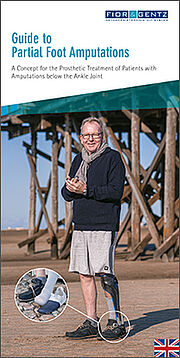Partial Foot Amputation
Amputation is the complete or partial surgical removal of limbs. The reason for an amputation is damage or an incurable injury. With partial foot amputations, the anatomical structures of the foot are amputated depending on the location of the damage. The ankle joint remains intact. An amputation always aims to remove the injured area completely while preserving as long a stump as possible. Every year, more than 50,000 people in Germany undergo a partial foot amputation. The causes of amputation are mainly arterial occlusive disease and diabetic foot syndrome (combined approx. 87%). Traumas as well as tumours and infections share second place by a wide margin (4% each).
To enable the patient to stand and walk as normally as possible again after a partial foot amputation, a prosthesis is used to replace the lost part of the foot. There is a wide range of sub-ankle or above-ankle options, which are produced depending on the level of the amputation and which have advantages but also disadvantages.

Where Can I Find out more about Partial Foot Amputation?
The Guide to Partial Foot Amputation, with its "Concept for the Prosthetic Treatment of Patients with Amputations below the Ankle Joint", is intended to provide a well-founded basis and to show new possibilities. A targeted classification with three different types of treatment was developed as a foundation for the present treatment concept.
You can download the Guide to Partial Foot Amputation free of charge here. Upon request, we will gladly send you a printed copy. Please contact our in-house customer service at info(at)fior-gentz.de or +49 4131 24445-0.
You can find an overview of the different system joints at ankle height here. The most important functions of each system joint are explained in the corresponding product description.
You can get to know patients who have already been treated with a prosthesis in our User Stories and Patient Videos. You can find the section on patients with partial foot amputation here.
